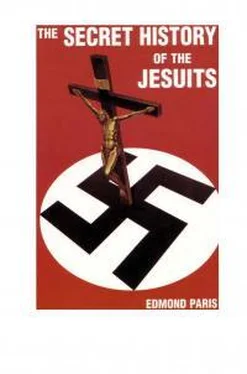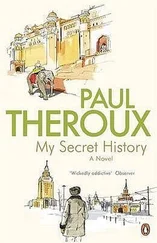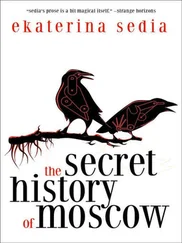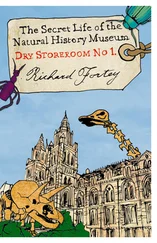So, it is claimed that Monseigneur Stepinac, "contested metropolitan", had no influence over these publications, of which he was president, and which constantly tried to surpass each other in their adulation of Pavelitch and his regime of blood.
Neither did he have any authority, so they say, over the "Oustachi"
bishops Sacric, Garic, Aksamovic, Simrak, etc., who showered praise on the Poglavnik and applauded his crimes, nor over the "Crusaders" of the Catholic Action, these auxiliaries of "Oustachi" converters, nor over the Franciscans murderers, nor over the nuns of Zagreb who marched past, their hands raised in the hitlerian fashion.
What a strange "hierarchy" which had authority over nothing and nobody!
The fact that he sat, with ten other Catholic priests, in the "Sabor"
("Oustachi" Parliament) does not compromise the archbishop—or, at least, we must presume this, as the fact is simply ignored.
We should not reproach him either for his presidency over Episcopal Conferences nor over the Committee for the application of the Decree concerning the conversion of Orthodox people. In this apology, the
"humanitarian" pretext of having made so many enter the Roman Church by force, is fully—and skilfully—expounded. We read this, concerning the
"awful dilemma" facing Monseigneur Stepinac: "His pastoral duty was to maintain intact the canonical principles but, on the other hand, dissidents who refused to embrace Catholicism were massacred; so, he lessened the severity of the rules."
We become even more bewildered when we read a little further on: "He tried to resolve this dramatic alternative in the circular letter of the 2nd of March 1942, in which he ordered the priests to closely screen the motives for conversion".
This is indeed a peculiar method to "attenuate the severity of the rules"
and resolve the "dramatic alternative"!
Was Monseigneur Stepinac opening or shutting the doors of the Roman Church to the false converts? It would be absolutely impossible to find it out if we referred only to this speech for the defence. The archbishop's apologists seem to choose the "shutting", though, when they declare: "... The cases of re-baptisms were very rare in the territory of Zagreb's
152
THE SECRET HISTORY OF THE JESUITS
archdiocese (92a)."
Unfortunately, statistics tell us otherwise, as we said earlier: "... In the diocese of Gornji Karlovac alone, part of Zagreb's archbishopric, 40,000 people were re-baptised".
It is evident that such results could be obtained only through mass-conversions of whole villages, such as Kamensko, in that same archdiocese of Monseigneur Stepinac, where 400 lost sheep returned to the Roman fold in one day, "spontaneously and without any pressure on the part of civil and ecclesiastical authorities".
Then why conceal these numbers? If they were really due to the
"charitable sentiments" of the Croatian Catholic clergy, and not to the cynical exploitation of terror, they should have been proud of them. The truth is that the veil thrown over these infamies in an attempt to hide them is transparent and not wide enough. To cover Stepinac, others have to be uncovered: Bishops Saric, Garic, Simrak, the priests Bilogrivic, Kamber Bralo and their associates—the Franciscans and Jesuits have to be uncovered, and finally the Holy See.
We might as well leave this peculiar archbishop to enjoy his "clear conscience", this primate of Croatia supposedly stripped of any authority, calling himself "metropolitan" when he wasn't so and who, to crown the paradox, was opening doors when shutting them. But, at the side of this fantastic prelate, there was another one, consistent and corpulent, the R.P.
Marcone, personnal representative of Pius XII.
Was this "Sancti Sedis legatus" also destitute of any authority over the Croatian clergy? Nobody knows! For the "dossier" so well expurgated makes no mention whatsoever of this great person; we could even be oblivious of his existence if we didn't have other information, such as photographs which show him officiating at Zagreb's cathedral, enthroned, amongst the "Oustachi"
general-staff, and above all sharing a meal with the family of Pavelitch, the
"practising" Catholic who organised the massacres.
Confronted by such a document, it is not surprising that the presence of the pope's representative was "blacked-out"; the mystics would call this
"enlightening darkness"! But these few lines from the "dossier" are even more enlightening:
"The procurator himself, in his bill of indictment, names the Holy See's Secretary of State, Cardinal Maglione, who had, in 1942, advised Archbishop Stepinac to establish more cordial and sincere relations with the
"Oustachi" authorities".(92b)
This is sufficient to put an end to any more quibbling.
(92a) R.P. Dragoun: "The Dossier of Cardinal Stepinac" (Nouvelles Editions Latines, Paris 1958, pages 46 and 163).
(92b) R.P. Dragoun: "The Dossier of Cardinal Stepinac", (Nouvelles Editions Latines, Paris 1958, p.32).
GERMAN AGGRESSIONS AND THE JESUITS
153
The collusion between the Vatican and the "Oustachi" murderers is clear enough. The Holy See itself was urging Monseigneur Stepinac to collaborate with them, and the personnal representative of Pius XII, by taking his place at Pavelitch's table, was applying the pontifical instructions to the letter: sincerity and cordiality in the relations with murderers of Orthodox believers and Jews.
This does not surprise us!
But what do the Jesuits think of it all, as they obstinately affirmed that the constant co-operation given to the dictators, by the prelates of His Holiness, was an "option" entirely personal and not dictated by the Vatican?
When Cardinal Maglione sent the previously mentioned recommendations to Zagreb's archbishop, was it his "personal option' he expressed, under the seal of the State's secretary's office?
The proof of the connivance between the Holy See and the "Oustachis"
supplied by the R.P. Dragoun, which has just been mentioned, puts an end to this chapter.
But here is a new confirmation of the evangelical sentiments which flourished, and still flourish amongst the faithful of the Croatian Catholic Church towards the Orthodox Serbians.
The "Federation Ouvriere Croate en France" (Federation of Croatian workmen in France) sent out an invitation to the solemn meeting organised for Sunday, 19th of April 1959, at the "General Confederation of Christian workmen" centre, in Paris, to celebrate the 18th anniversary of the foundation of the "Oustachi" Croatian state.
This invitation read: "The ceremony will start with holy mass being said at the Church of Notre-Dame-de-Lorette. But the reader, edified by this pious start, is the more startled when he discovers, soon after, this straight exhortation: "DEATH TO THE SERBIANS... !"(93) So, this not so banal document expresses the regrets that not more of these
"brothers in Christ" were killed.
The book of the R.P. Dragoun, rector of the Croatian Mission in France, implies that the welcome given by the French Catholics to the Croatian refugees was not warm enough. We are told this on pages 59 and 60, and, on pages 280 and 281, the author mentions the "grevious disappointment" these refugees experienced at "being met by a total lack of understanding on the part of their brothers in the faith".
Considering the aforementioned document, this "lack of understanding" seems comprehensible; we are glad that our fellow-countrymen, in sp i t e of the most grand invitations, show little sympathy to a form of piety in which the call to murder walks hand in hand with the "holy mass", in the best Roman and
"Oustachi" tradition. We would be even more glad if such (93) Cf. "Le Monde", 19th of April 1959.
154
Читать дальше












